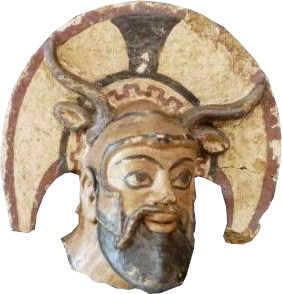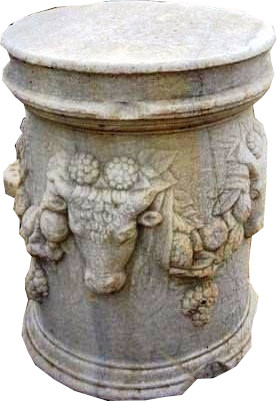Ancient Psychedelia: Alien Gods & Mushroom Goddesses
Online Book - Chapter 11, Page 177
Back to Online Book Mainpage / Next Page (Chapter 11, Page 178)
The Etruscans were an advanced civilization that flourished in Italy between the 8th and the 3rd century BC, and they are considered Italy’s first great civilization. There were many similarities between the Etruscan and Greek cultures apparent in the paintings and illustrations, dress styles and figurines (59d, h).   R: (59h) Etruscan Antefix c. 500 BC The Achaeans were a Patriarchal Greek people who invaded Thessaly around 1900 BC, at the time of the late Minoan age. Thessaly was inhabited at the time with two groups of people whom the Achaeans called the Pelasgians or “sea-farers.” The Pelasgians were originally Ophits, who claimed to be born from the teeth of the cosmic snake Ophion. Achaeans who occupied Argos took the name of the Danaans while those who remained in the north of the Isthmus of Corinth were called Ionians, worshipers of the Cow Goddess Io. (14) Around 1250 BC, a divide was occurring between two groups of Achaeans who lived a short distance from one another. The Achaean Danaans, who had developed their culture and worked alongside the Pelasgians and were ardent followers of the goddess, and the Achaeans who invaded the Peloponnese, who founded a patriarchal dynasty which revolved around the newly formed Olympian pantheon of goddesses and gods, who were all equally represented at first but later grew more and more patriarchal. Early Greek myths involve numerous disputes between Zeus and Hera, with Zeus always being the promiscuous lover and Hera, the jealous quarreling wife. With Zeus as the head, Poseidon as his brother, and Apollo as his son, the male family was solidified. The early changes were resisted among the Danaan Achaeans and the Pelasgians, but ultimately prevailed as the dominant mythology and way of life. (15) Pliny records in Natural History that the Latin alphabet was derived from the Pelasgian. (16) According to Graves, Pythagoras is supposed to have been a Tyrrenian Pelasgian from Samos in the Northern Aegean which gave him access to Orphic and Druidic ideologies. (17) |
The descendants of Crete may well include the Graeco-Libyans and the Thraco-Phrygians. (15) In Phrygia, in ancient times, a sect there called the “ophiogeneis,” which means “descendants of the snake,” held that their ancestor was a child who was born by a woman who mated with a serpent in the sacred forest of Artemis. (18) Graves states that the Egyptian alphabet was brought by IO, daughter of King Inachus, a river-god and king of Argos, who gave them to the Egyptians. IO later became Isis in Egypt. King Inachus was also the father of Phoroneus, founder of the Pelasgians, the originators of the alphabet. The Pelasgians have been identified with Bran/Kronos. (19) According to Ruck, the word mushroom is cognate with mucus in English and Latin and means “slime.” Mushroom is also derived from Old English via Old French from the Latin mussirio, and Latin musso, ultimately back to Greek muao, meaning, to make the ”moo” sound, which can also imply mum as in “no sound,” hence it is cognate with Mystery (Greek musterion). (20) This seems to be another connection whereupon the founding of the name of the mushroom may have been derived from the sound a cow makes, which humans imitate when we hear them “mooing.” Our first attempts at language communication may have been the imitation of the cow’s primal sound. The Greek word “myeo” is a verb which means “to initiate.” From the Scythian town of Gota (Olbia) (modern Ukraine), which translates to The Place of the Cows, c. 800-500 BC, cisterns are found which have cows engraved on them, with what I assume to be mushroom cap buttons above their heads (27b). If they are not mushrooms caps, I’m at a loss to explain what they could be.  (27b) Scythian town of Gota (Olbia) Ukraine (The Place of the Cows) c. 800-500 BC (14) ibid, p. 62 (15) White Goddess, p. 64 (16) ibid, p. 228 (17) ibid, p. 69 (18) Strabo quoted in G. Thomson, "Tarih Oncesi Ege." 1st 1995. op. cit., p. 136 (19) White Goddess, p. 233 (20) Apples of Apollo, p. 80 |
Go Back to Page 176